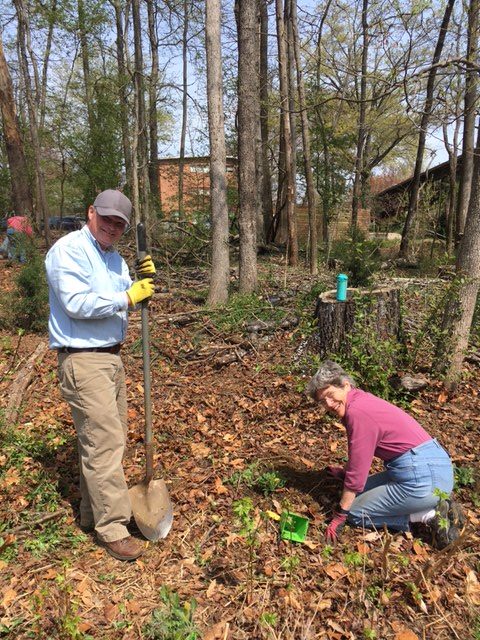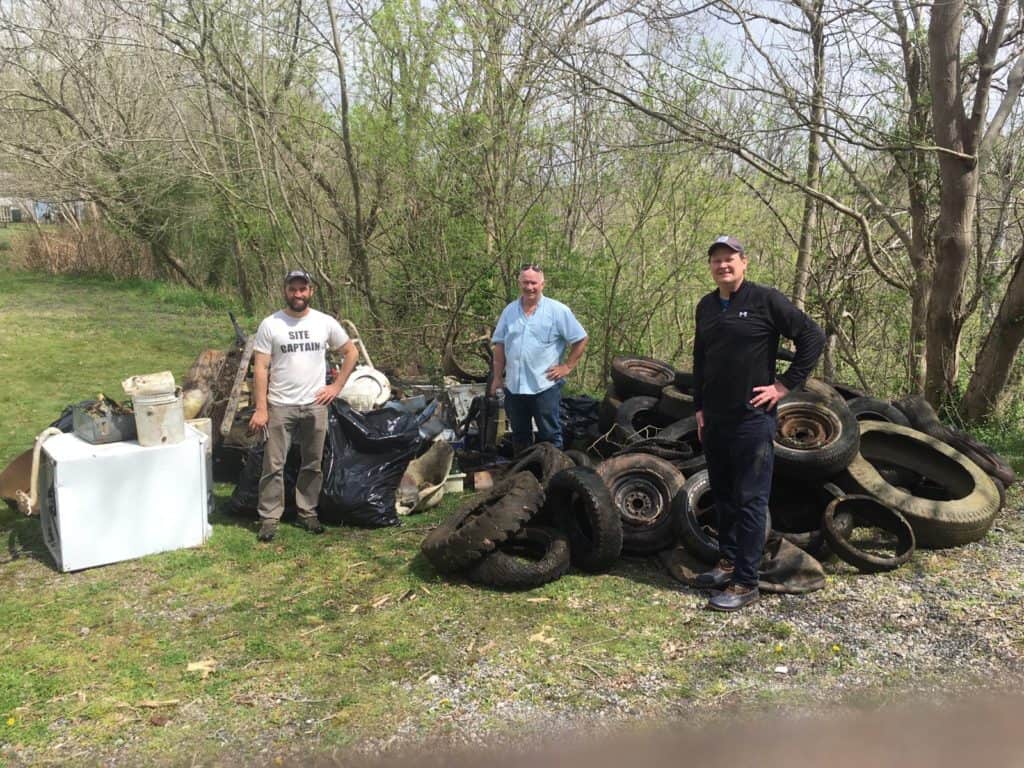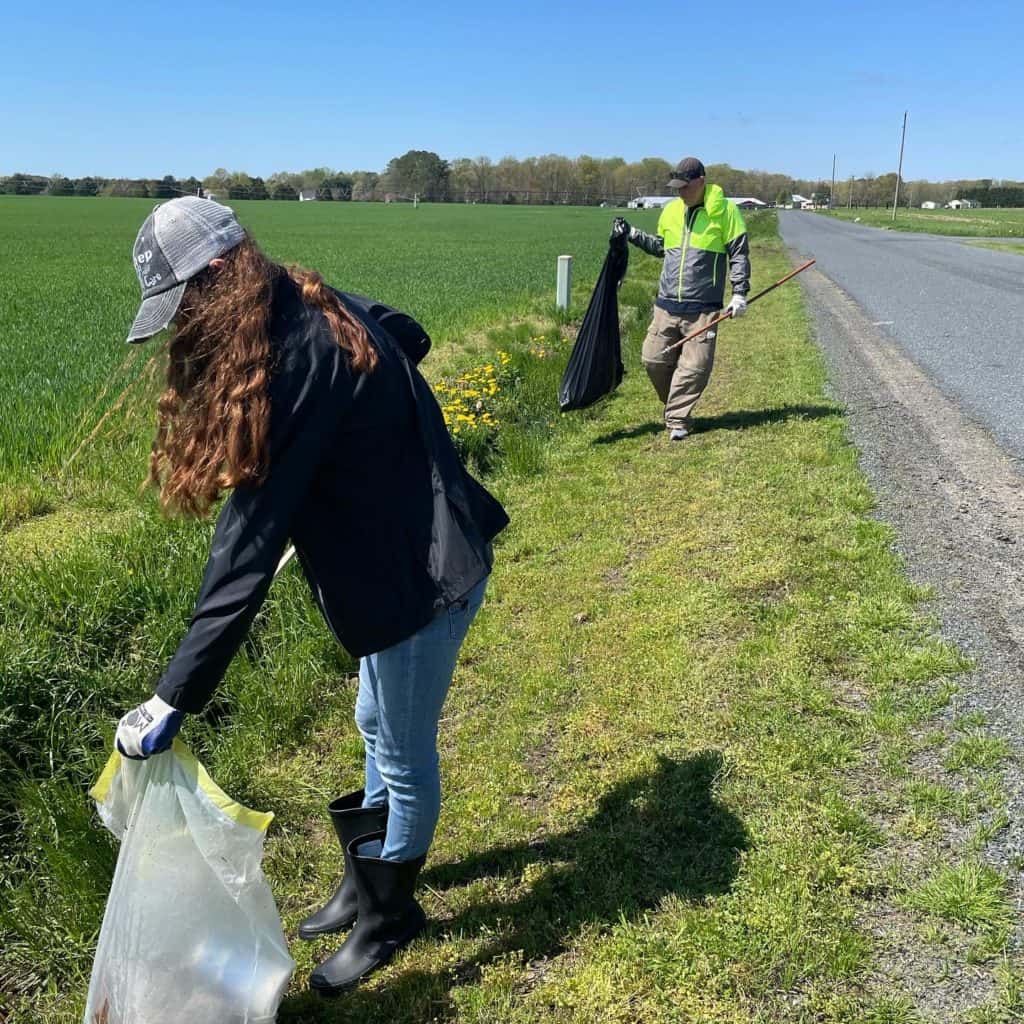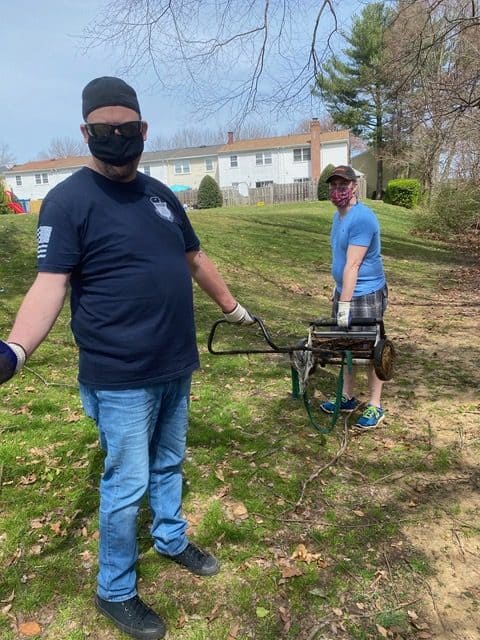Trash Talking
Simple Steps Towards a Big Impact
By Kathy Knotts
Taking care of our environment has moved beyond a fringe movement in the 1970s into the mainstream in the 21st century. The Biden administration hosts a global climate summit on Earth Day this year, adding to the many important environmental events that have happened on April 22 since 1970, the year Earth Day began, including the recent signing of the Paris Agreement.
While few of us here on the Chesapeake Bay will be meeting with world leaders to hash out how to keep our planet green and thriving, we do have the opportunity to make a difference in smaller, simpler ways. It begins with picking up trash—and it’s easier than you think.
The Alliance for the Chesapeake Bay has been hosting Project Clean Stream, its annual watershed-wide cleanup initiative, since 2004. Since its launch, PCS has seen a significant increase in the number of cleanup events, volunteers, and trash removed. What started as a single-day event is now a year-round effort.
Project Clean Stream, organized and funded by the Irvine Nature Center in Owings Mills in Baltimore County, started as a one-day cleanup every year on the first Saturday in April. After 10 years, writes Lucy Heller of the Alliance, they started to gain more and more interest to the point that volunteers offered to host events in other areas.
Now, tens of thousands of volunteers come together annually to pick up trash from local streams, creeks, rivers, parks, and neighborhoods as part of Project Clean Stream, says Heller. The Alliance makes it easy for anyone to participate. With over 65 registered events this year, all you have to do is sign up and show up—or register your own event. The Alliance provides the supplies you need (gloves and trash bags) and the platform for recruiting volunteers to your effort. “We provide supplies for cleanups anywhere in the Chesapeake Bay watershed: all six Bay states and the District,” says Heller.
The Alliance works with residents, local businesses, environmental organizations, local governments, community groups, houses of worship, schools and universities, helping them take action to restore clean waters to local streams, creeks, and rivers. Volunteers have the opportunity to pick up trash in their communities, discover how their everyday decisions affect the overall health of their local waterways, and ultimately foster a healthier and more sustainable relationship with the Chesapeake.
The broad reach of Project Clean Stream is making a measureable difference. Alliance averages roughly 2.5 million pounds of trash removed with more than 500,000 volunteers across thousands of clean-up sites.
What’s the big deal with trash? Beyond just being an eyesore, trash endangers wildlife and pollutes our waters, affecting aquatic vegetation, macroinvertebrates, fish, birds—no living thing goes untouched by the presence of trash. Birds and sea turtles especially mistake bits of plastic for jellyfish, and filter feeders cannot make the distinction between food and trash. Grazing or scavenging animals ingest plastic that has been used to hold human food.
Cleaning up litter is a simple activity that has immediate rewards. Anyone can do and once you start looking you find it everywhere: little bits of plastic, cigarette butts, bottle tops, pull tabs, fishing line, deflated balloons, tires, even furniture.
What could make a sweaty, dirty outing entertaining? Keeping track of the strange items volunteers find. During cleanup events already held this year, Heller reports that volunteers found the following: 10 cans of used dirty oil, $200, car parts, an unopened bag of Scott’s Turf Builder, a 2×4 with deck screws still embedded, a mop, a car hood, a vintage television, graffiti painting supplies, a car bucket seat, and a microwave.
American Rivers reports that cigarette butts are the top item found in cleanups, and although they weigh one gram or less, they account for 30 percent of all litter in the United States. The second most commonly found item is plastic water bottles, followed by food packaging, plastic bags and aluminum cans.
Volunteers turned out two weeks ago for a cleanup at Patuxent Wetland Park, reports Debra Gage, Jug Bay volunteer coordinator. “We had 12 people participate, including four teenagers. We entered all trash into the Clean Swell app, which is a global snapshot of ocean trash, providing researchers and policy-makers insight to inform solutions. It takes a little longer when using the app but we were able to collect 326 pounds of trash.”
One of the teens helping out was Lillianne Davis, president of the newly formed Environmental Engineers Club at South River High School. “Over the summer I volunteered with Jug Bay and I knew this was a great organization to be involved with and that our club could work with. So I signed us up for the Project Clean Stream event.”
Davis says she has helped pick up trash in other places but this time felt a little different. “Being in quarantine for a year, it was just nice to get outside and back into nature.”
She says her group filled multiple bags of trash with things like fishing nets and cigarette butts. “One of the teams found a toy dog!” Davis explains the trash problem isn’t likely to go away soon, even if cleanups continue. “It helps the ecological systems in the area in the short term. But I think the problem will continue because people throw things on the ground if it’s convenient.”
Davis does say she will continue to do her part to clean up the world around her and recommends other teens find similar events to participate in. The environment is important to her because, “I live in it and we should protect it since we inhabit the land.”
A group at St. Luke’s Episcopal Church in Eastport organized their own Project Clean Stream event, focused on removing invasive species, planting native groundcover in the woods and trash pickup. The Rev. Diana Carroll, rector, reported that many of the volunteers were first-timers.
Nancy Merrill Sullivan with the Arundel Rivers Federation is organizing a cleanup for Earth Day as well. Although they did not host any cleanups in 2020, they do monitor three streams annually “that just collect an incredible amount of trash every year.” Yet Sullivan wonders if the pandemic has had an effect on the amount of trash reaching their sites.
“I went to all three streams and while there was some trash there, there wasn’t nearly enough for 10 people to clean up,” says Sullivan. “I don’t know if the Alliance did clean ups in the fall there or whether [it’s] because less people are shopping and out and about, but there was less trash.”
Over in Cape St. Claire, volunteers are preparing for a cleanup this weekend along the Magothy River. The community has been hosting cleanup events for several years, only pausing when COVID forced them to. “We were a little nervous about doing it this year,” says Brad Knopf, a graduate of the inaugural class of Watershed Stewards, member of the Magothy River Association and the Cape Conservation Corps. “We had to skip last year and that made everybody sad. But we have lots to do around Cape St. Claire, lots of creeks and waterfront to clean up. We were worried about making room for our usual 80 to 100 people who show up to help.”
Knopf says volunteers will be split into three work groups to allow for better distancing and to abide by COVID protocols. He says that just getting together may have more of an impact than the actual trash collection. “The biggest thing is getting people involved, the outreach aspect of it. People feel so good doing it, spending a day outside for a good purpose with your family, your friends, your neighbors. It’s every bit as important as getting rid of the trash.”
The volunteers combine efforts for some heavy lifting, Knopf says. Some years the group has collected upwards of 4,000 pounds of trash. “I mean lots and lots of bags full of god-knows-what. Giant metal things, giant wooden things, one year we found most of a car rusting away down in a creek. It’s shocking the things you find.”
Want to organize a cleanup? It’s all about location. Choose a place that has trash but is also not impossible to get to, a place where trash is blown about that could end up in waterways, which ultimately lead to the Bay. Sign up on the Alliance website and spread the word.
“The Alliance is awesome, and the Chesapeake Network website is amazing. I find that to be a really useful resource. They will give you all the details for planning. It’s not hard to get involved,” says Knopf.
Picking up trash may seem like a small gesture, but it can have a big impact on the health of the Chesapeake Bay waters that we cherish and depend on. Every piece of trash collected serves as a reminder of the responsibility to protect our shared resources by taking individual action to fight pollution at the source.







